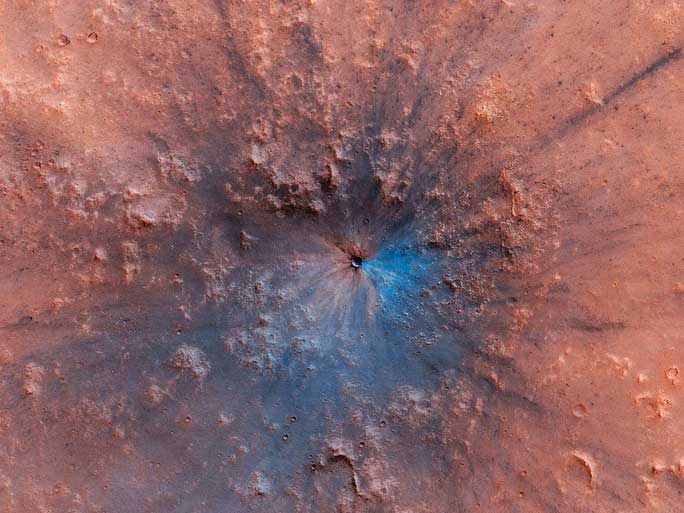Mars may be the planet that “bombards” Earth the most. It has inadvertently revealed an unusual and highly anticipated fact through these meteorites.
A team of scientists from the Scottish Universities Environmental Research Centre (SUERC), University of Glasgow, University of Edinburgh, Natural History Museum in London (UK), Lawrence Livermore National Laboratory, and the University of California, Berkeley (USA) has collected a series of “Martian meteorites” and pointed out a strange impact pattern.
Mars meteorites are not rare on Earth, as this neighboring celestial body frequently rains down small and large fragments onto our planet.

A crater on Mars – (Photo: NASA).
In fact, this stems from Mars’ “misfortune”: It is also a planet that is frequently bombarded, with at least 200 large impacts each year, thus releasing a large amount of debris into space. Earth unfortunately is right next to it.
The unusual point that the British-American research team discovered is that most Martian meteorites are “young” rocks, dated only a few hundred million years old.
This led the group to initially believe that measuring the age of the meteorites mostly yielded incorrect results. This is because planetary evolution models almost certainly indicate that the surface of the Red Planet ceased to be disturbed billions of years ago. In other words, Mars is considered a “dead” planet.
According to the authors, this strange information about the meteorites could provide clues about the journey they took to reach Earth, as well as the geological processes within Mars.
“They were blown off the Red Planet by major impact events. There are tens of thousands of impact craters on Mars” – volcanic researcher Ben Cohen from the University of Glasgow, the lead of the study, stated.
Out of 360 Martian meteorite samples, scientists identified 302 samples as shergottites, a type of Martian rock rich in metals forged under the heat of volcanic activity. They are all quite “young”, ranging from 160 to 540 million years old.
The surface of Mars is quite old, so the only scenario is that the impacts were so strong that they shattered the surface deeply enough to “unearth” younger rock layers beneath, propelling them into space and eventually shooting them to Earth.
There is only one possible explanation: Mars has still been volcanically active beneath its surface until recently!
This aligns well with evidence of strange seismic waves on Mars that NASA’s InSight robot and China’s Zhurong (Zhu Rong) rover have recorded.
Therefore, this discovery provides evidence that the interior of the Red Planet is not truly dead, as geological activity in the form of volcanoes and minor earthquakes still exists, bringing new hope for the search for life.


















































